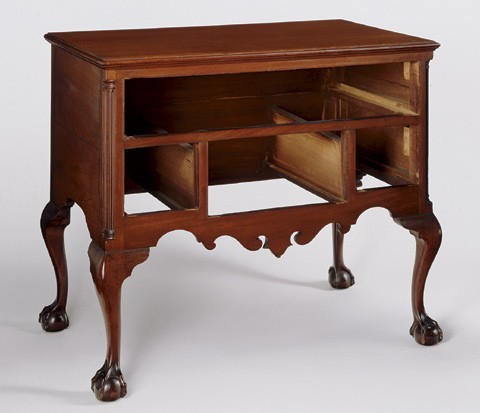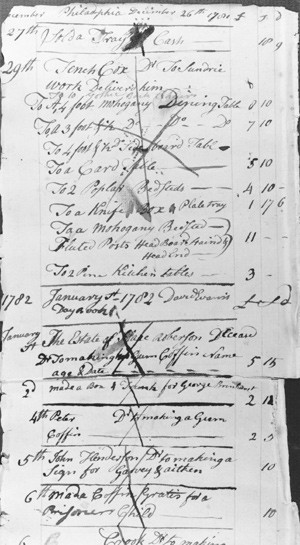
High chest by Henry Cliffton and Thomas Carteret, Philadelphia, Pennsylvania, 1753. Mahogany with tulip poplar, white cedar, and yellow pine. H. 95 1/2", W. 44 1/4", D. 22 1/2". (Courtesy, Colonial Williamsburg Foundation.)

Detail of the case construction of the high chest illustrated in fig. 1. (Photo, Gavin Ashworth.) The upper section of the high chest also has dustboards under the drawers.

Detail of the lower case construction of the high chest illustrated in fig. 1. (Photo, Gavin Ashworth.)

High chest attributed to Henry Cliffton and Thomas Carteret, Philadelphia, Pennsylvania, 1750–1755. Mahogany with tulip poplar, white cedar, and yellow pine. H. 94 1/2", W. 45", D. 23 5/8". (Chipstone Foundation; photo, Gavin Ashworth.)

Detail of the pediment of the high chest illustrated in fig. 4. (Photo, Gavin Ashworth.)

Detail of the center cartouche on the high chest illustrated in fig. 4. (Photo, Gavin Ashworth.)

Side chair by James Gillingham, Philadelphia, Pennsylvania, 1768–1773. Mahogany with yellow pine. H. 38 3/4", W. 23 1/2", D. 18 1/2". (Courtesy, White House.)

Benjamin Gasburn, “A Plan of the City of Philadelphia, the Capital of Pennsylvania,” London, 1776. 18 7/8" x 24 3/4". (Courtesy, Winterthur Museum.)

Dressing table attributed to David Evans, Philadelphia, Pennsylvania, 1774. Mahogany with tulip poplar and white pine. H. 30 1/2", W. 35 1/8", D. 20 1/2". (Courtesy, Philadelphia Museum of Art; bequest of Lydia T. Morris.) When she acquired this dressing table in 1774, Beaulah Paschall lived in two homes. The family townhouse, which she probably shared with her brother Joseph, was on Market Street in Philadelphia. Her country house, Cedar Grove, was in Frankford, Pennsylvania. She had inherited it from her mother, Elizabeth Coates Paschall. This dressing table and its mate were intended for one of these homes. The one shown here descended in the Paschall family to Lydia Thompson Morris, who gave it and other ancestral furniture of the Wistar and Morris families to the Philadelphia Museum of Art in 1932.

Dressing table attributed to David Evans, Philadelphia, Pennsylvania, 1773–1810. Walnut with tulip poplar and white pine. H. 31 3/4", W. 35 1/2", D. 21 1/2". (Courtesy, Philip H. Bradley Company; photo, Gavin Ashworth.)

Detail of the rear board of the dressing table illustrated in fig. 9. The cabinetmaker used scribe marks to align the nails used to attach the partitions. (Photo, Gavin Ashworth.)

Detail of the interior construction of the dressing table illustrated in fig. 9. (Photo, Gavin Ashworth.)

Entry for December 29, 1781, David Evans Daybooks, Philadelphia, Pennsylvania, 1774–1812. (Courtesy, Historical Society of
Pennsylvania.)

Dining table attributed to David Evans, Philadelphia, Pennsylvania, 1773–1810. Mahogany with oak, tulip poplar, and white pine. H. 28 1/4", W. 48", D. 59 1/2". (Private collection; photo, Gavin Ashworth.) Like the dressing tables illustrated in figs. 9 and 10, the dining table has end rails with flattened stepped arches.

Armchair attributed to David Evans, Philadelphia, Pennsylvania, 1773–1795. Mahogany with white pine. H. 38", W. 23 1/2", D. 18". (Private collection; photo, Gavin Ashworth.) The armchair is stamped “d.evans” on the inside of the rear rail and the underside of the slip seat.

Card table attributed to David Evans, Philadelphia, Pennsylvania, 1788. Mahogany with black walnut and tulip poplar. H. 29 1/2", W. 35 1/2", D. 17". (Courtesy, Philadelphia Museum of Art; photo, Gavin Ashworth.) This card table was one of a pair. The hardware is original.

Detail of the flyrail and knuckle joint of the card table illustrated in fig. 16. (Photo, Gavin Ashworth.)

Detail of the flyrail and swing leg of the card table illustrated in fig. 16. (Photo, Gavin Ashworth.)

Tall clock case attributed to David Evans with an eight-day movement by David Rittenhouse, Philadelphia, Pennsylvania, 1789. H. 93", W. 23 1/3", D. 12 3/4". (Courtesy, University of Pennsylvania Art Collection; photo, Gavin Ashworth.)

Detail of the hood of the tall clock case illustrated in fig. 19. (Photo, Gavin Ashworth.)

Detail showing the foot construction of the tall clock case illustrated in fig. 19. (Photo, Gavin Ashworth.)

Tall clock case attributed to David Evans with a thirty-hour movement by Benjamin Rittenhouse, Philadelphia, Pennsylvania, 1788. Dimensions and woods not recorded. (William MacPherson Hornor, Blue Book: Philadelphia Furniture [1931; reprint, Alexandria, Va.: Highland House, 1988], pl. 111.) Benjamin Rittenhouse made the movement as a wedding present for Jonathan and Elizabeth (Rittenhouse) Sergeant. Elizabeth was Benjamin’s niece.
